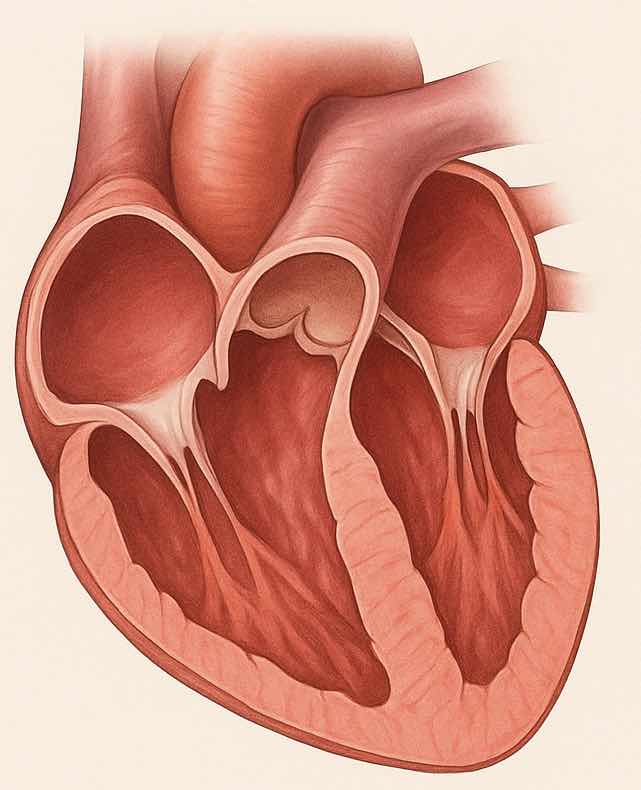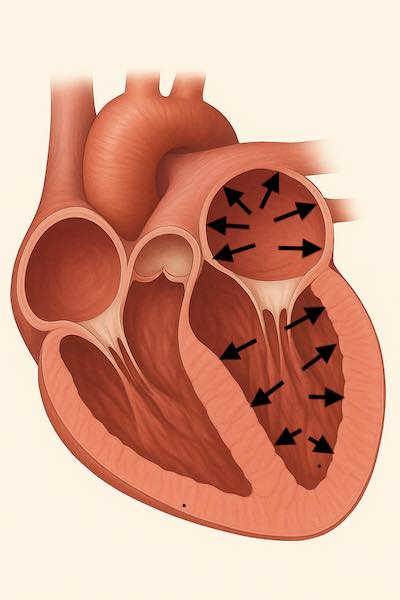What does pimobendan do to help in degenerative mitral valve disease?
❤️ Pimobendan (known as Vetmedin / Cardisure) has amazing benefits to treat DMVD. Should all dogs with a heart murmur get pimobendan?
Published on: July 13, 2025
Reviewed on: July 13, 2025

Pimobendan is a fantastic drug for treating the stage B2 – remodelling – phase of the mitral valve degenerative process. It does this by boosting the heart muscle contractility (known as an inotrope). Its mechanism for doing this is fascinating but will come to that somewhere else. Here we want to know how it actually helps in degenerative valve disease.
Should you give it to every dog though? This is a tricky one. For sure many dogs with a heart murmur may have mitral valve disease. And some of these will have remodelling of the heart and therefore benefit from pimobendan. However, a very large number of dogs with heart murmurs that are asymptomatic will not need or benefit from this drug.
Stage B1
As far as we know, there is absolutely no benefit from pimobendan in the early stages of the disease. The mitral valve is shutting nice and securely with just a small backwards leak, and the heart is compensating for the leak with no problems. It does this by increasing the muscle contractility. It is only when the heart’s ability to compensate by increasing the contractility is exhausted that it then switches in to a new strategy: remodelling.
If we imagine giving a heart that is normal size and beating fairly normally a drug like pimobendan you can see it is going to do no help at all, the muscle will likely get over sensitised and might even cause issues in the degenerative process by putting more strain on the valve and supporting structures.
Amazingly some dogs will stay in B1 for many years before progressing, and some actually never progress to B2. So these dogs would be given a huge expense of unnecessary medication and potentially even be worsened by taking this drug at this stage.
Stage B2


Stage B2 is characterised by remodelling. The heart is getting bigger in size, to help it try to increase the amount of blood it can pump, as it can no longer compensate just by boosting muscle contractility.
This stage carries much more concern, because the increasing heart size stretches the valve annulus and worsens the mitral valve support structure, making the leakage much worse.
The worsening leakage causes the heart to get bigger still, and the bigger heart stretches and distorts the valve even more, in a nasty worsening cycle.
At this stage the pimobendan will finally start to have benefit, because by boosting the contractility of the muscle, it can interrupt this cycle and get the heart pumping more blood without needing to increase in size. Indeed in many cases we can see reverse remodelling, where the heart starts shrinking again.
This is an amazing effect, as it effectively works to hold back the ever worsening situation and allow the dog a normal life for longer. Studies estimate it delays the onset of the next stage of the disease by about 15 months on average.
Sadly of course the degenerative processes in the valve do continue, and eventually heart failure becomes inevitable.
Stage C
Heart failure is the eventual outcome of this process. The valve is leaking very severely and the heart’s ability to adapt is exhausted, so the pump starts to fail.
You can imagine the function of any pump as maintaining a pressure difference. This pressure difference is what drives the flow of fluid. In the case of the left heart, the failing of the pump causes a backing up of pressure behind the heart as it can no longer cope with all the blood arriving through the lungs from the right heart.
We can measure this in echocardiography by looking at the left atrium. This chamber started enlarging in Stage B2 and now starts to experience a higher pressure than normal. Estimating this pressure is pretty complex and a separate topic. But it can be done, and this is what starts sounding the warning. Cardiologists often talk about a ‘restrictive profile’ and this is a really big concern.
This high pressure in the left atrium soon causes problems. Fluid is no longer able to drain from the lungs into the left atrium, and so instead ends up leaking into the fluid spaces, causing breathlessness.
Clearly pimobendan should already be used by this point, as the heart needs all the help it can get. If it hasn’t been used in stage B2, then we have likely lost some of its protective benefits, but some recovery is often still possible.
Usually diuretics are also essential at this point, and these are now the life saving drugs that can work alongside pimobendan to keep the heart working as normally as possible.
So what do I do if my dog has a heart murmur?
Hopefully it is clear from the above discussion, that pimobendan should only be used in stage B2 disease or beyond. If dogs followed a predictable course in this disease, then it would be sensible to have some basic rules of when to start the drug.
Instead dogs are hugely variable, with some dogs staying for years is stage B1 or never progressing at all. So in these cases there would be unnecessary expense and hassle and potential danger involve in giving a drug completely unnecessarily.
So currently the best course of action is to have a regular echocardiogram done on your dog, by a veterinarian or cardiologist competent to at least measure the left atrial and left ventricular sizes accurately and to look for signs of remodelling.
This should ideally be repeated about every 6-12 months until there are clear signs your dog has entered stage B2.
← Back to Blog
